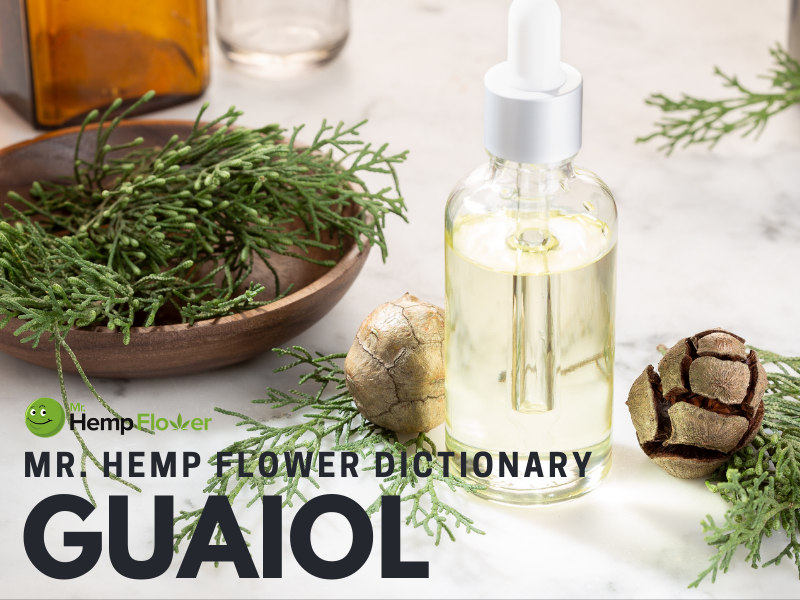Guaiol – What Is It? All You Need To Know About Guaiol

Guaiol
ˈg(w)īˌȯl | Noun
Guaiol is sesquiterpene alcohol occurring naturally in hemp and other plants like the cypress pine. The oil of the guaiacum plant contains this terpene in abundance — and, as you may notice, it’s the plant from which guaiol derives its name. Also referred to as champacol, this terpene possesses a floral, woody scent and exhibits potential antibacterial properties.
“I’m tasting a woody, rose-like flavor in my Strawberry Jam hemp pre-roll, maybe from the guaiol in it.”
“Did you know that both hemp and the guaiacum plant native to South America contain the terpene guaiol?”
What is guaiol terpene?
Unlike many oil-based terpenes in plant life, guaiol is an alcohol-based terpene found frequently in hemp. This terpene bears deep roots in holistic medicine through the use of the guaiacum plants. The Spanish brought these plants to Europe in the 16th century after discovering San Domingo — today’s Haiti and the Dominican Republic. Back in the day, Europeans used it as an experimental cure for syphilis.
If you’ve ever visited the Caribbean or South America, you might have noticed this plant along the coastline. It exhibits lush flowers with striking purple hues and produces high amounts of guaiol. Back in the day, people used it to naturally treat pain, sore throat, rheumatism, menstrual symptoms, and sexually transmitted diseases.
What does it smell like?
This terpene exhibits a delightful woody aroma with undertones of rose. It emits a fresh and invigorating scent profile comparable to the sensation of walking into a wood full of evergreen trees.
What is it used for?
Like many terpenes, it’s used in commercially sold insecticides, aromatherapy, and as a perfume ingredient. You may find it on labels of different household items listed as an aromatic. It’s present in spices like nutmeg and cumin, fruits like apples, and lilac flowers. This terpene is also a component of essential oils like tea tree oil. You might’ve experienced its benefits through common medicines used for treating congestion and cough.
What are the benefits of this terpene?
Researchers are investigating the effects of this terpene. Anecdotal evidence shows its long tradition in medicine, primarily in South America. So far, we know it possesses potential anti-inflammatory, pain-relieving, and antibacterial properties.
Antibacterial and antioxidant properties
Native to Brazil, the fruit of Xylopia sericea contains an essential oil rich in guaiol terpene (up to 14%). One 2017 study published in the Journal of Pharmacy and Pharmacology revealed the antibacterial and antioxidant effects of this essential oil. The study highlights its effectiveness in killing Staphylococcus aureus — one of today’s most problematic bacterium responsible for staph infections.
The study also revealed that its antimicrobial effects could serve for food preservation. Like many terpenes, guaiol exhibits significant antioxidant activities. Antioxidants are natural molecules mostly found in plant foods that help neutralize harmful free radicals in our bodies. Created from exposure to X-rays, cigarette smoking, pollution, and so forth, free radicals are responsible for aging and a potential host of diseases.
The entourage effect
As a secondary terpene found in many hemp strains and a primary terpene in a range of full spectrum CBD products (like CBD kief), guaiol plays a vital role in the entourage effect. The entourage effect is a theory suggesting that all hemp compounds act synergistically to modulate the plant’s healing properties. In doing so, this terpene helps the body’s endocannabinoid system to maintain balance or homeostasis.
Where to find it in hemp?
You can find it in hemp strains like Cat’s Meow Hemp Flower and Strawberry Jam Hemp Flower, present as a secondary terpene along linalool and pinene. Want to experience this terpene’s flavor in a higher concentration? Try this CBD Kief crafted from the strain Hawaiian Haze, loaded in bisabolol and guaiol.
Final thoughts
Used in natural medicine for centuries, this terpene shows antibacterial and antioxidant effects that lean towards potential pain-relieving and anti-inflammatory benefits.
